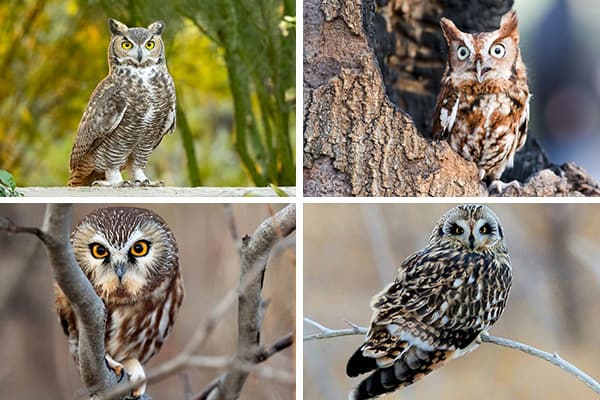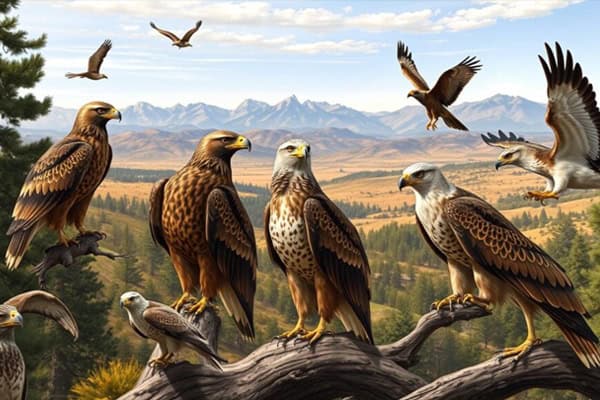8 Species of Owls in Massachusetts (With Photos & Guide)
Are you curious about the mysterious world of owls in Massachusetts? These enigmatic creatures have captured the imagination of people for centuries, with their silent flight and haunting calls. But did you know that Massachusetts is home to not one, not two, but eight different species of owls? Join us on a journey through the diverse habitats and behaviors of these majestic birds as we uncover the secrets of owls in the Bay State.
Key Takeaways:
- Massachusetts is home to eight different species of owls.
- Owls in Massachusetts have diverse habitats and behaviors.
- From the Eastern Screech-Owl to the Snowy Owl, each species has unique characteristics.
- Knowing where to look can increase your chances of spotting these elusive creatures.
- Exploring the world of owls in Massachusetts can be a fascinating and rewarding experience.
Explore Types Of Owls in Massachusetts
1. Eastern Screech-Owl
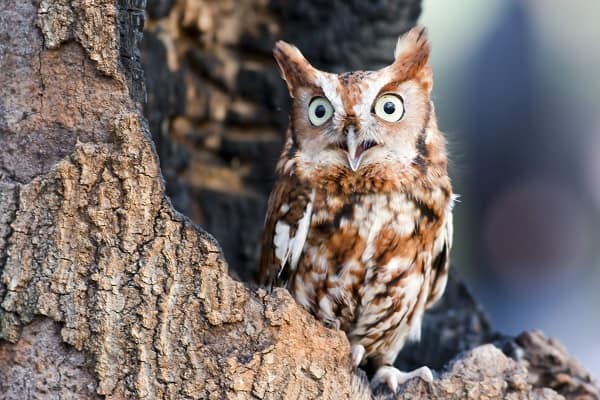
The eastern screech-owl is one of the native owl species found in Massachusetts. With its distinctive trilling call, this small owl brings a touch of enchantment to the Bay State. Despite its name, the eastern screech-owl rarely screeches; instead, it produces a variety of vocalizations, including soft whinnies and trills.
This adaptable owl can be found in a variety of habitats, from dense forests to urban parks and suburban neighborhoods. It is known to nest in tree cavities, making it beneficial to conserve mature trees that provide suitable nesting sites.
If you’re eager to spot an eastern screech-owl in Massachusetts, be sure to explore wooded areas with plenty of mature trees. Look for abandoned woodpecker holes or hollow branches, which may serve as the owl’s chosen nesting spots.
Habitat:
The eastern screech-owl can be found in forests, parks, and suburban areas throughout Massachusetts.
Diet:
This owl primarily feeds on small mammals, such as mice, voles, and shrews. It also preys on insects, birds, and occasionally, reptiles.
Size and Appearance:
The eastern screech-owl is a petite species, measuring around 8 to 10 inches in length. It has distinct ear tufts on its head and can come in two color variations: red and gray morphs. The red morph has reddish-brown plumage, while the gray morph showcases gray and brown tones. This natural camouflage helps the owl blend into its surroundings.
Spotting a red morph eastern screech-owl in a forested area can be quite challenging due to its excellent camouflage. On the other hand, gray morph individuals may be more easily observed against the bark of trees.
| Common Name | Scientific Name | Length | Weight | Wingspan |
|---|---|---|---|---|
| Eastern Screech-Owl | Megascops asio | 8-10 inches | 6-7 ounces | 18-24 inches |
2. Great Horned Owl

The great horned owl is one of the largest owl species in Massachusetts. Named for its prominent ear tufts, this majestic bird is a top predator in the state, with powerful talons capable of capturing prey as large as rabbits and skunks. As a nocturnal hunter, the great horned owl has exceptional night vision and silent flight, making it a formidable predator in the dark.
Habitats and Behaviors
Great horned owls have a diverse range of habitats, from dense forests to open grasslands. They are highly adaptable and can be found in both rural and urban areas, including parks, gardens, and even city suburbs. These owls prefer nesting in large trees, often repurposing the abandoned nests of other birds, such as hawks or crows.
The great horned owl is known for its distinct hooting call, which can be heard echoing through the night. Mating season for great horned owls typically begins in late winter, with pairs establishing territories and mating calls serving as a way to attract mates and defend their territory.
Spotting a Great Horned Owl in Massachusetts
- Visit wildlife refuges and conservation areas with mature forests, such as the Blue Hills Reservation or Mass Audubon sanctuaries, where great horned owls are known to nest and hunt.
- Look for their nests in tall trees, especially during the breeding season when you may spot adults and their fluffy owlets.
- Explore open areas with nearby wooded patches, as great horned owls often hunt in fields and meadows but roost in trees.
- Listen for their distinctive hoots and calls during the evening and early morning, as they are most active during these times.
Spotting a great horned owl in Massachusetts can be a thrilling experience. Just remember to maintain a respectful distance and avoid disturbing these amazing creatures in their natural habitats. With patience and a little luck, you may catch a glimpse of this magnificent owl soaring through the night sky or perched high on a branch.
Must Read Hummingbirds in Missouri
3. American Barn Owl

The American barn owl (Tyto furcata), also known as the common barn owl, is a fascinating and enigmatic bird that can be found in the state of Massachusetts. With its ghostly appearance and silent flight, encountering this unique owl species is a truly remarkable experience.
The American barn owl belongs to the family Tytonidae, which includes around sixteen species of owls worldwide. However, in Massachusetts, it is considered a rare sighting, making it a sought-after bird for birdwatchers and nature enthusiasts.
This particular species of barn owl is known for its heart-shaped face, pale plumage, and long wings. Its large eyes are dark and expressive, allowing it to see well in low-light conditions and search for prey with precision. The American barn owl is primarily nocturnal, meaning it is most active during the night, and it hunts small mammals such as mice, voles, and shrews.
When it comes to habitat preference, the American barn owl typically inhabits open grasslands, agricultural fields, marshes, and, as its name suggests, barns and other structures. It is an adaptable owl species that can tolerate a wide range of environments, making it a potential inhabitant of rural and suburban areas in Massachusetts.
If you’re interested in observing the American barn owl in Massachusetts, it’s important to keep in mind a few factors. Firstly, its nocturnal nature means that it is most active during the night and roosts during the day, making nighttime excursions more promising for sightings. Secondly, areas with suitable habitats, such as open grasslands or fields with abundant prey, are more likely to attract the American barn owl.
While Massachusetts is not considered a primary breeding ground for this species, occasional sightings of American barn owls have been reported in different parts of the state. These sightings are often met with great excitement and provide valuable opportunities for researchers to study and better understand this elusive owl species.
In conclusion, the American barn owl is a rare and captivating species that can be found in Massachusetts. Its ghostly appearance, silent flight, and unique habitat preferences make it an intriguing owl to encounter in the Bay State. Remember to explore open grasslands, agricultural fields, and potential roosting sites if you aspire to catch a glimpse of this fascinating bird.
4. Barred Owls in Massachusetts
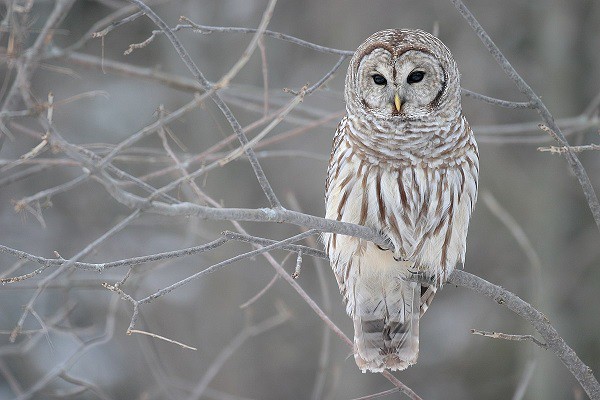
In Massachusetts, the barred owl is a common and recognizable species among the owl population. This majestic bird is known for its distinctive call, often described as “who cooks for you.” With its dark round eyes and unique barred plumage, the barred owl stands out among other species.
The preferred habitat of the barred owl is the forested areas of Massachusetts, where it can find suitable roosting spots and abundant prey. This species has adapted well to the state’s forests, making it easier to spot during hikes or nature walks.
Characteristics of the Barred Owl
The barred owl is a medium-sized owl, measuring around 17-24 inches in length. It has a wingspan of 38-49 inches, allowing for efficient flight through wooded areas. One distinctive feature of the barred owl is its dark brown eyes, which contrast against its light-colored facial disk.
The plumage of the barred owl consists of horizontal bars and streaks, giving it a barred or striped appearance. The underparts are pale and slightly lighter in color. These adaptations help the barred owl blend in with its surroundings, making it an effective hunter.
Also Read Woodpeckers in Texas
Preferred Habitats
As mentioned earlier, the barred owl prefers forested areas. It can be found in both deciduous and mixed hardwood forests, as well as coniferous forests with dense understory vegetation. These birds prefer habitats near water sources, such as swamps, marshes, and rivers, as these areas attract a diverse range of small mammals, their primary food source.
While exploring the forests of Massachusetts, keep an eye out for large tree cavities or nest boxes, where barred owls may choose to nest. These owls are typically territorial and maintain a home range throughout the year.
Comparing Barred Owls to Other Owl Species in Massachusetts
| Owl Species | Size | Distinctive Features | Habitat | Preferred Prey |
|---|---|---|---|---|
| Barred Owl | 17-24 inches | “Who cooks for you” call, dark eyes, barred plumage | Forests, swamps, marshes, rivers | Small mammals (voles, mice, rabbits) |
| Eastern Screech-Owl | 8-10 inches | Small size, trilling call | Forests, parks, suburban areas | Small mammals, birds, insects |
| Great Horned Owl | 18-25 inches | Ear tufts, powerful talons | Forests, open areas | Various mammals, birds, reptiles |
| American Barn Owl | 12-15 inches | Ghostly appearance, silent flight | Open fields, grasslands | Small mammals, rodents |
| Short-Eared Owl | 13-17 inches | Distinctive facial discs, preference for open grasslands | Grasslands, marshes | Small mammals (voles, mice), birds |
| Long-Eared Owl | 13-16 inches | Long ear tufts, muted coloration | Woodland areas, coniferous forests | Small mammals, birds, insects |
| Northern Saw-Whet Owl | 7-9 inches | Small size, fierce hunter | Forests, woodlands | Insects, small mammals, birds |
| Snowy Owl | 22-28 inches | Striking white plumage | Coastal areas, open fields | Small mammals (lemmings, voles), birds |
5. Short-Eared Owl
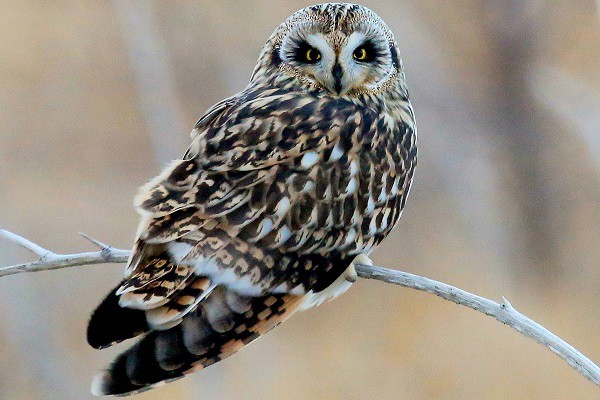
Distinctive Facial Discs and Grassland Habitats
The short-eared owl is a unique species that can be found in Massachusetts. These owls are known for their distinctive facial discs, which help to enhance their hearing abilities and locate prey in low-light conditions. While they are not as commonly seen as some other owl species in the state, their presence in open grassland habitats makes them a fascinating bird to observe.
The short-eared owl’s facial discs, consisting of concentric circles of feathers around their eyes, act like satellite dishes, funneling sound to their ears and enabling them to accurately locate prey, even in the darkness of dusk and dawn.
Unlike many other owl species, short-eared owls prefer open grasslands, such as meadows, farmlands, and marshes. These flat, open areas provide an ideal hunting ground for these birds, as they rely on their exceptional hearing and keen eyesight to detect small mammals, including voles, mice, and rabbits.
During the breeding season, short-eared owls perform mesmerizing aerial displays known as “sky dances.” These displays involve intricate flight patterns, with the owls swooping, gliding, and hovering in mid-air, all while emitting soft hoots and wing clapping sounds.
To increase your chances of spotting a short-eared owl in Massachusetts, head to areas with open grasslands, such as coastal marshes, wet meadows, and airport fields. Be sure to visit during the owl’s active periods, which are typically around dawn and dusk.
Remember to take precautions and respect the owl’s natural habitat. Keep a safe distance to avoid disturbing the owls during their hunting or nesting activities. Binoculars or a spotting scope can be helpful for observing these birds from a distance without causing any disturbance.
Keep in mind that short-eared owls are migratory birds, meaning their presence in Massachusetts may vary throughout the year. Some individuals may only visit during the winter months, while others may stay and breed in the state during the summer.
| Short-Eared Owl Quick Facts | |
|---|---|
| Scientific Name | Asio flammeus |
| Habitat | Open grasslands, meadows, marshes |
| Size | Approximately 13-17 inches (33-43 cm) in height |
| Wingspan | Approximately 38-43 inches (97-109 cm) |
| Diet | Primarily small mammals (voles, mice, rabbits), occasionally small birds |
| Conservation Status | Least Concern |
6. Long-Eared Owl

The long-eared owl (Asio otus) is a fascinating nocturnal owl species that can be found in Massachusetts. These owls are known for their distinctive long ear tufts, which are actually just feathers and not ears. Despite their name, the tufts are not actual ears but serve a purpose in communication and camouflage.
The long-eared owl is commonly found in woodland habitats, where their muted coloration helps them blend in with their surroundings. These secretive owls are most active during the night, hunting for small mammals such as mice and voles. They rely heavily on their exceptional hearing to detect prey in complete darkness.
Although they are not as common as some other owl species in Massachusetts, dedicated birdwatchers and nature enthusiasts can spot long-eared owls in the state. They are most frequently seen in dense forests and woodlands, roosting in dense tree canopies during the day and emerging at dusk to hunt.
If you’re interested in seeing a long-eared owl, here are a few tips:
- Visit areas with dense forests or woodlands, particularly those near open fields or wetlands.
- Look for long-eared owls roosting in tall trees with dense foliage.
- Be patient and observant. Long-eared owls are secretive and well-camouflaged, so spotting them may require keen eyes and careful observation.
- Consider joining a local birdwatching group or participating in guided owl walks, which can offer expert insights and increase your chances of spotting these elusive birds.
“Long-eared owls are incredibly adaptive and have managed to thrive in a variety of habitats across their range. They are excellent hunters and play a vital role in controlling rodent populations, making them an important species to conserve.” – Jane Anderson, Massachusetts Birding Society
Long-Eared Owl Facts
| Species | Long-Eared Owl |
|---|---|
| Scientific Name | Asio otus |
| Size | Approximately 35-40 cm in length and a wingspan of 95-110 cm |
| Habitat | Woodlands, forests, and mixed habitats with open areas |
| Diet | Mainly small mammals such as mice and voles, occasionally birds |
| Status | Stable population, but considered a species of concern in some regions |
While encountering a long-eared owl in Massachusetts may require some effort and luck, the experience of observing these beautiful and elusive creatures in their natural habitat is truly rewarding. Remember to respect their space and observe from a distance, allowing them to thrive undisturbed.
You may want to read Black Birds with White Belly
7. Northern Saw-Whet Owl
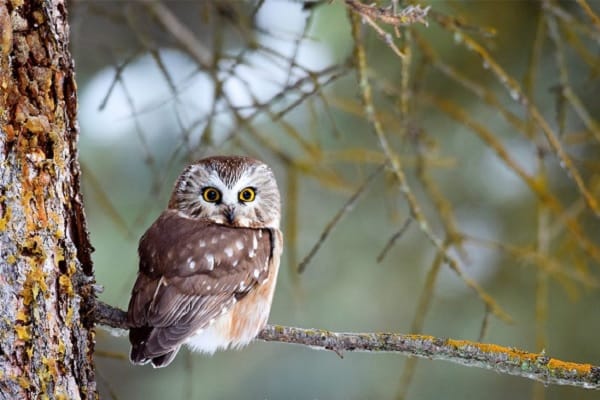
The Northern Saw-Whet Owl is a small and elusive owl species that is found in Massachusetts. Despite its small size, this owl is a skilled hunter and is capable of taking down prey that is much larger in size. With its sharp saw-like beak and excellent hearing, the Northern Saw-Whet Owl is a formidable predator in the night.
These owls prefer dense forests and woodlands, where they can find plenty of cover and a diverse range of prey. They are particularly fond of hunting small mammals, such as mice and voles. Their stealthy nature and excellent camouflage make them difficult to spot, even for experienced birdwatchers.
If you’re interested in observing Northern Saw-Whet Owls in Massachusetts, it’s important to be patient and quiet. Look for areas with a dense canopy and plenty of undergrowth, such as mixed coniferous-deciduous forests. Dawn and dusk are the best times to catch a glimpse of these owls as they begin their night-time hunting activities.
Remember:
“Northern Saw-Whet Owls are known for their distinctive “tooting” call, which sounds like a repetitive series of high-pitched notes. By listening for their calls and scanning the treetops, you may have a chance to spot these elusive creatures in their natural habitat.”
Here is a table that compares the key features of the Northern Saw-Whet Owl:
| Feature | Description |
|---|---|
| Size | Small, measuring about 7-8 inches in length |
| Plumage | Brown with white streaks and spots |
| Habitat | Dense forests and woodlands with plenty of cover |
| Prey | Small mammals, such as mice and voles |
| Call | Distinctive “tooting” call |
By understanding the unique features and behavior of the Northern Saw-Whet Owl, you can increase your chances of spotting and appreciating these fascinating creatures in their natural environment in Massachusetts.
Related Article Owls in Arkansas
8. Snowy Owl
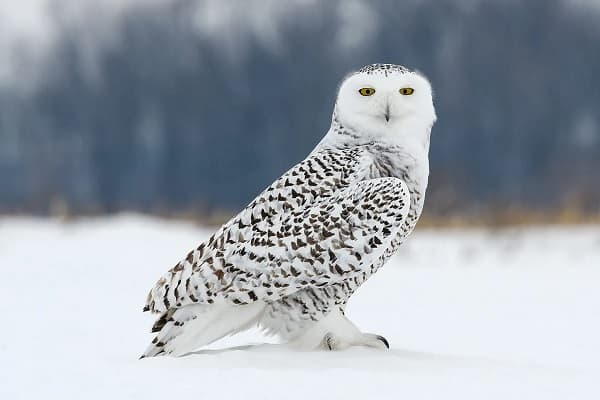
The snowy owl is a magnificent bird that occasionally graces Massachusetts with its presence during the winter months. With its striking white plumage and piercing yellow eyes, the snowy owl is a true embodiment of grace and beauty.
Unlike many other owl species, snowy owls are diurnal, meaning they are active during the day. This makes them easier to spot and observe compared to their nocturnal counterparts. They prefer open areas such as beaches, dunes, and coastal marshes, where they can hunt for their favorite prey – small rodents.
During the winter, snowy owls migrate south from their breeding grounds in the Arctic. Some of them find their way to Massachusetts, providing bird enthusiasts with a rare opportunity to catch a glimpse of these majestic creatures in person.
“Spotting a snowy owl in all its snowy splendor is a truly magical experience. It’s like encountering a mythical creature in the wild, and it never fails to take my breath away.” – Jane Peterson, avid birdwatcher
If you want to increase your chances of seeing a snowy owl in Massachusetts, head to coastal areas where they are known to frequent. Popular spots include Plum Island, Duxbury Beach, and Sandy Neck Beach. Keep in mind that snowy owls are protected species, so it’s important to observe them from a respectful distance and follow ethical birdwatching practices. Binoculars or a spotting scope can be helpful for a closer look without causing disturbance.
Snowy Owl Characteristics
| Characteristic | Description |
|---|---|
| Size | Large, with a wingspan of up to 5 feet |
| Plumage | Pure white with scattered dark markings |
| Eyes | Intense yellow or golden eyes |
| Habitat | Coastal areas, dunes, and open landscapes |
| Behavior | Diurnal, active during the day |
| Prey | Primarily small rodents |
Observing a snowy owl in its natural habitat is a truly unforgettable experience. So, grab your binoculars, bundle up, and head to the coast for the chance to witness the beauty of these iconic birds.
Where to Look for Owls in Massachusetts
If you’re an avid birdwatcher or simply fascinated by owls, Massachusetts is a great place to spot these majestic creatures. With its diverse landscapes and abundant natural areas, the Bay State offers numerous opportunities to observe owls in their natural habitats.
When searching for owls in Massachusetts, it’s essential to know where to look. Forested areas, such as state parks and wildlife refuges, are often excellent locations to find owls. Keep an eye out for Eastern Screech-Owls and Barred Owls, which are commonly found in wooded areas.
If you prefer wetland habitats, marshes and swamps are worth exploring. These areas attract owls like the Great Horned Owl, which can often be spotted perched on tree branches near wetland edges.
For those seeking a unique owl encounter, open fields and grasslands provide the ideal setting to spot Short-Eared Owls and Northern Saw-Whet Owls. These species prefer open habitats and are known for their distinctive behaviors and appearances.
Remember, when searching for owls, patience and silence are key. Owls are mainly active during the night, so consider venturing out during dawn or dusk when they may be more active. Don’t forget to bring binoculars and a field guide to help identify these fascinating birds.
So, whether you explore the forests, marshes, or open fields, keep these tips in mind to maximize your chances of encountering owls in Massachusetts. With a little luck and careful observation, you’ll be rewarded with unforgettable sightings of these captivating creatures.
Frequently Asked Questions
Q1: Are owls common in Massachusetts?
Yes, owls are relatively common in Massachusetts, with various species found throughout the state.
Q2: Does Boston have owls?
Yes, owls can be found in and around Boston, as the city is part of the broader Massachusetts habitat that supports various owl species.
Q3; Do barn owls live in Massachusetts?
Yes, barn owls are known to inhabit Massachusetts, and they can be found in a variety of habitats across the state.
Q4: Do snowy owls live in Massachusetts?
Yes, snowy owls do visit Massachusetts, especially during the winter months. They are known for occasional irruptions, where they migrate south in search of food, bringing them to the state.

